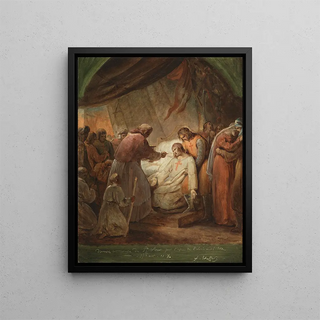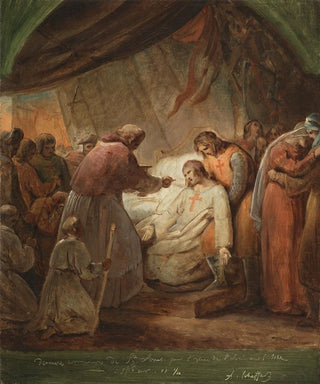Art print | The Last Communion of Saint Louis - Ary Scheffer


View from behind

Frame (optional)
In the rich and complex universe of romantic art, "The Last Communion of Saint Louis" by Ary Scheffer stands out for its emotional depth and spiritual message. This artwork, created in 1850, evokes a moment of grace and devotion, where the saintly King Louis IX, an iconic figure of the Middle Ages, prepares to receive the Eucharist. The scene, imbued with solemnity, invites the viewer to contemplate the fragility of the human condition in the face of divine transcendence. The depiction of this sacred rite, both intimate and universal, resonates with a power that transcends eras, making this painting a true masterpiece of faith and piety.
Style and uniqueness of the work
Ary Scheffer's style is a subtle blend of romanticism and classicism, characterized by meticulous attention to detail and a palette of delicate colors. In "The Last Communion of Saint Louis," the faces of the characters are filled with poignant expressiveness, revealing a psychological depth that inevitably draws the eye. The drapery of the garments, carefully rendered, adds a tactile dimension to the composition, while the soft light bathing the scene creates an almost ethereal atmosphere. The dynamic between shadow and light emphasizes the moment of communion, highlighting the spirituality emanating from this work. Every element, from the serene face of the king to the anxiety of the surrounding figures, contributes to a rich and evocative visual narration.
The artist and his influence
Ary Scheffer, born in 1795 in Dordrecht, is one of the major figures of the French Romantic movement. Trained at the Paris Academy, he absorbed the ideas of his contemporaries while developing a personal style that emphasizes emotion and spirituality. His work is marked by a fascination with religious and historical themes, often inspired by literature and poetry. Scheffer was able to capture the very essence of his subjects, giving them a nearly mythological dimension. His influence extends beyond his era, inspiring many artists who seek to explore the depths of the human soul through art. "The Last

Matte finish

View from behind

Frame (optional)
In the rich and complex universe of romantic art, "The Last Communion of Saint Louis" by Ary Scheffer stands out for its emotional depth and spiritual message. This artwork, created in 1850, evokes a moment of grace and devotion, where the saintly King Louis IX, an iconic figure of the Middle Ages, prepares to receive the Eucharist. The scene, imbued with solemnity, invites the viewer to contemplate the fragility of the human condition in the face of divine transcendence. The depiction of this sacred rite, both intimate and universal, resonates with a power that transcends eras, making this painting a true masterpiece of faith and piety.
Style and uniqueness of the work
Ary Scheffer's style is a subtle blend of romanticism and classicism, characterized by meticulous attention to detail and a palette of delicate colors. In "The Last Communion of Saint Louis," the faces of the characters are filled with poignant expressiveness, revealing a psychological depth that inevitably draws the eye. The drapery of the garments, carefully rendered, adds a tactile dimension to the composition, while the soft light bathing the scene creates an almost ethereal atmosphere. The dynamic between shadow and light emphasizes the moment of communion, highlighting the spirituality emanating from this work. Every element, from the serene face of the king to the anxiety of the surrounding figures, contributes to a rich and evocative visual narration.
The artist and his influence
Ary Scheffer, born in 1795 in Dordrecht, is one of the major figures of the French Romantic movement. Trained at the Paris Academy, he absorbed the ideas of his contemporaries while developing a personal style that emphasizes emotion and spirituality. His work is marked by a fascination with religious and historical themes, often inspired by literature and poetry. Scheffer was able to capture the very essence of his subjects, giving them a nearly mythological dimension. His influence extends beyond his era, inspiring many artists who seek to explore the depths of the human soul through art. "The Last






